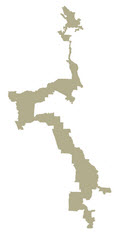Is It End Times for Our Democracy?
Rigging the system to make sure who wins Mar 4 2013In a democracy, citizens get to vote and who gets the most votes, wins. That's how it's supposed to work, but that is less and less the case in our heavily compromised “democracy”.
There has always been tampering with the electoral machinery — the practice of reshaping election districts called “gerrymandering” is named for a law signed by governor of Massachusetts back in 1812 — but the last few years have seen concerted campaigns to rig elections and to make voting difficult for targeted groups.
The 2010 census was central to the process. The Constitution calls for apportioning the 435 House seats according to each state’s population. States with populations that, over the decade leading to the decennial census, expanded or shrunk in proportion to other states enough to gain or lose in the number of representatives they may send to Washington, had to change the number of electoral districts to match. That affects all surrounding districts and sets off general state remapping. After 2010, eight states gained, all in the South and West, and ten lost, all Midwest and East Coast (except Louisiana, depleted by Katrina).
But states not affected take advantage of the census, too. It’s open season for the party in power to redraw electoral districts to their advantage.
By 2010, Republicans had taken over the gubernatorial slots in 30 of the 50 states, often with both branches of their legislatures Republican-controlled. The power of redistricting resides with the state legislature, subject to the governor’s signature in most states. They went to work re-drawing the maps, reshuffling to an unprecedented degree.
Once complex enough to limit its use, gerrymandering has become easy with software products like Maptitude developed for the purpose. The task is to pack as many neighborhoods with opposition voters into as few as possible throwaway districts and spread your supporting voters across other districts in such a way that they are a majority in all the rest. The resulting shapes are often tortured, cynical contrivances, good for a rueful laugh.

Florida's 5th district

Pennsylvania's 7th district

North Carolina's 12th district
In 2012, the remapping results were quite spectacular.
• In Wisconsin, the majority of votes for president, the senate and the state legislature were for Democrats, yet Republicans won control of the state legislature and sent 5 Republicans to Congress vs. 3 Democrats.
• Much the same in Pennsylvania: about 83,000 more Democratic votes than Republican yet the delegation sent to Congress is stacked 13-to-5 with Republicans.
• In Virginia, Democratic candidates won almost 50% of the votes but only 27% of congressional seats.
• In Ohio, 48% of the vote went to Democrats but only a quarter of the delegation are of that party.
• North Carolina’s vote for congressional seats went 51% for Democratic candidates. How many took seats in the Capitol? Four Democrats, nine Republicans.
Do Democrats gerrymander? Most certainly — in states such as Illinois and Maryland, where Democrats controlled and got to redraw the maps. But thanks to their 2010 state-level gains just prior to the census, This tally says Republicans controlled redistricting in states with 40% of the seats in the House, whereas Democrats controlled it in states with only 10% of the seats.
Republicans not only had the upper hand, but were organized like no party before to use gerrymandering to control House elections. It was all part of a plan called “Redmap”. Coordinated by the Republican State Leadership Committee with a $30 million budget, it first focused on taking over state legislatures by 2010, and then using that power to redraw the district maps.
The plan worked. A New York Times analysis reported that, “In seven states where Republicans redrew the districts, 16.7 million votes were cast for Republicans and 16.4 million votes were cast for Democrats. This elected 73 Republicans and 34 Democrats”, a stunning outcome. For all 50 states, Democrats held a 1.4 million edge in votes for representatives, yet Republicans still control the House, by a 234 to 201 margin. “This is only the second such reversal since World War II”, says that analysis. By engineering majorities in garrisoned districts, redistricting is chipping away at the fundamental democratic principle that the natural majority decides.
one false moveCreating impregnable districts where one or the other party is guaranteed a safe seat in Congress will have the effect of amplifying polarization to the level of extremism. How? In such a district, the opposition party becomes extinct. Its voters are effectively disenfranchised because their vote counts for nothing. The monopoly party is affected, too. For them, the general election becomes only a formality to anoint whoever wins the primary. To win that primary, a candidate will have to guard every word to make sure he or she is in lock step with party dogma. Once in Washington, facing another primary in less than two years, there can be no variance from the creed, else the zealots will wreak vengeance. Compromise earns a political death sentence. Permanent gridlock is institutionalized. Former Tennessee Representative John Tanner said this to a writer at The Atlantic:
“Look, everyone knows we have a structural deficit, and the only way out of it is to raise revenues and cut entitlements... But what happens? The Democrats look over their left shoulder, and if someone suggests cutting a single clerk out of the Department of Agriculture, they go crazy. Republicans look over their right shoulder, and if someone proposes raising taxes on Donald Trump’s income by $10, they say it’ll be the end of the world. So these poor members come to Washington paralyzed, unable to do what they all know must be done to keep the country from going adrift, for fear that they’ll get primaried.”
We have a new word — “primaried” — meaning a candidate for re-election is sent packing for any deviance from doctrine while in office. So stacked are districts already that Tanner says we are down to less than 100 of the nation’s 435 congressional districts where House members are decided in the general election and not in the primaries.
on to the presidencyRedistricting to freeze out Democrats served Republicans well in keeping control of the House but Obama won the presidency handily owing to the winner-take all practice of states awarding all their electoral votes to the winner of the statewide popular vote. No harm done yet by redistricting to the presidential election considering that Obama got 52% of the vote, almost 5,000,000 more than Romney. But there are proposals in the state legislatures to put an end to the majority deciding who should be president by instead awarding Electoral College votes according to which party wins each district in their state.
Nebraska and Maine already assign their votes this way. If all 50 states had done so, Romney would have beaten Obama 276-262 in the Electoral College. That reversal is what Republican-controlled state houses have their eye on. Legislation being introduced in Michigan would align all but two of its 16 electoral votes with district outcomes, with only the last two awarded to the statewide majority winner.
A Virginia legislator wanted to take it a step further, giving those last two to whichever presidential candidate won the most districts. That scheme would have given Romney 8 electors instead of all 13 going to Obama under winner-take-all. That Obama won the state by a 150,000 margin would have meant nothing. The bill’s sponsor said he “wants to give smaller communities a bigger voice”; that is, give unequal voting power to some and take from others. A new democracy concept. Because cities tend to vote Democratic and are more populous, the district scheme aims to tilt the playing field toward rural communities, which tend to vote Republican, and away from the majority deciding who wins. We saw how that succeeded in the redistricting examples above.
Moves are afoot in Florida, Ohio, Pennsylvania and Wisconsin to switch to district-based awarding of electors as a way to see to it that Romney’s equivalent wins next time, no matter the majority vote.
voting impedimentsRepublicans conducted a parallel campaign to make it difficult for certain groups to vote in the 2012 election. Laws requiring that voters identify themselves by government-issued documents with photos, no matter how long a person had been on the voting rolls, drew the most attention because they were premised on a lie: they were to combat non-existent “voter fraud”. We covered this in these three pieces last year that mocked how silly voter fraud is as a way to derail an election’s results even if it did exist. Of course the real intent was to deter blacks, Latinos and students from voting — three groups that traditionally vote Democratic — by making it problematic for lower income people to get time off from jobs, sacrificing pay, and likely having to pay for the ID, which amounted to the return of a poll tax. The effect was to dissuade hundreds of thousands of American citizens from exercising their right to vote, but that sure stopped bogus voter fraud dead in its tracks.
Other obstacles to that most basic right in a democracy were shortened early voting periods; wholesale removal of citizens from voting rolls; long waits to vote, particularly by allocating too few voting machines in Democratic city districts, allegedly designed to make people quit; and tactics such as Florida’s forbidding voter registration on Sundays, when African-Americans have traditionally conducted registration drives after church services.
It’s a different morning in America. Changes in laws in states across the country, now in place, will take years to extricate, and there is no sign of any counter-movement to do so. That leaves us with a phony democracy contrived to make sure the next time around that Republicans will continue to hold the House, will win the presidency and possibly the Senate no matter which party gets the majority of votes. And it doesn’t even cover what possibly will be the biggest change of all coming down the road as the Supreme Court considers the 1965 Voting Rights Act. For that, see this companion story.
Please subscribe if you haven't, or post a comment below about this article, or
click here to go to our front page.


You lost me in the first paragraph. We are not–nor ever have been, a democracy. We are a democratic republic. A majority mob in a democracy can be just as totalitarian and stomp on individual rights as a single person.
It is pretty simple to fix. “The boundaries of a voting districts dividing a larger area can be composed only one to four continuous straight lines.”
Interesting that you made that point. In an earlier post we had said
“What is lamentable is that the same software logic could be used to rid us of gerrymandering for good. Beginning by dividing a state into the nearest to equal size rectangles that irregular borders and waterways permit, each area could then be iteratively adjusted in shape and size — with no regard whatever to political parties and ethnic groups — until optimally equal populations occupy each district. Job done.”